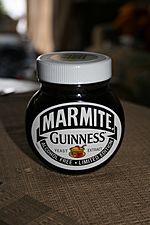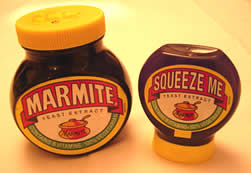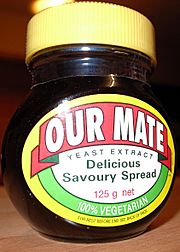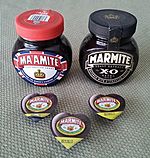Marmite facts for kids
| Lua error in Module:WikidataIB at line 168: attempt to index field 'wikibase' (a nil value). | |
| Type | Yeast extract spread |
|---|---|
| Inventor | Lua error in Module:WikidataIB at line 168: attempt to index field 'wikibase' (a nil value). |
| Inception | Lua error in Module:WikidataIB at line 168: attempt to index field 'wikibase' (a nil value). |
| Manufacturer | Lua error in Module:WikidataIB at line 168: attempt to index field 'wikibase' (a nil value). |
| Available | Yes |
| Current supplier | Unilever |
| Website | Lua error in Module:WikidataIB at line 168: attempt to index field 'wikibase' (a nil value). |
Marmite is a British food spread with a strong, savory taste. It was invented in 1902 by the Marmite Food Company. This unique spread is made from yeast extract, which is a leftover product from making beer. The company Unilever now produces Marmite.
Marmite is a dark brown, sticky paste. It has a very distinct, salty, and powerful flavor with a strong smell. Because of its unique taste, Marmite's famous slogan is: "Love it or hate it." Many people in the United Kingdom use Marmite as an example of something that people either really like or really dislike. Marmite is known for its savory taste because it has a lot of glutamate.
The picture on the Marmite jar shows a marmite. This is a French word for a large cooking pot with a lid. Marmite was first sold in these earthenware pots. But since the 1920s, it has been sold in glass jars. The special shape of Marmite jars comes from a German glass company called Gerresheimer.
Other similar spreads include Vegemite from Australia and Cenovis from Switzerland. There is also a different version of Marmite made in New Zealand since 1919. This New Zealand version has a different recipe. It is the only one sold as Marmite in Australia and the Pacific Islands. The British version is sold everywhere else.
Contents
History of Marmite
Before Marmite, the first yeast extract spread was created in the late 1800s. A German scientist named Justus von Liebig found that yeast from brewing beer could be made into a food. At first, it was hard to make this yeast extract for sale.
Then, in 1902, the Marmite Food Extract Company started in Burton upon Trent, England. Marmite became its main product. The yeast needed for the spread came from the Bass Brewery. The first Marmite makers had to create new machines and ways of making it. This was because British beer yeast was different from yeast used in other countries.
By 1907, Marmite was so popular that a second factory was built in London.
In 1912, scientists discovered vitamins. This was great for Marmite because the spread has many B vitamins. During World War I, many soldiers had a lack of vitamin B1. Because Marmite was rich in B vitamins, it became very popular. British soldiers even received Marmite as part of their food rations.
In the 1930s, a doctor named Lucy Wills used Marmite to help treat a type of anaemia in workers in India. She later found that folic acid was the helpful ingredient. Marmite was also used to help people who were not getting enough food during a malaria outbreak in Sri Lanka in 1934–35. People were told to use Marmite carefully because there was not much of it.
In 1990, Marmite Limited was bought by CPC International Inc. This company later became Best Foods Inc. Then, in 2000, Best Foods Inc. joined with Unilever. Today, Unilever owns the Marmite brand.
Other Yeast Spreads
There are several other yeast products in different countries. These are not directly linked to the original Marmite recipe. The Australian spread Vegemite was made in the early 1920s. It was created by a chemist named Cyril Callister because there was not enough Marmite being sent to Australia during World War I. Vegemite is now sold in many countries.
Other similar products include OzeMite, Cenovit from Brazil, Vitam-R from Germany, and Cenovis from Switzerland. In the United Kingdom, many supermarkets also sell their own brands of yeast extract. These are very similar to Marmite.
How People Use Marmite
Marmite is usually eaten as a savory spread. People put it on bread, toast, crackers, or other baked foods. Because its taste is so strong, it is often spread very thinly. People usually spread it with butter or margarine. You can also make a hot drink by adding a teaspoon of Marmite to hot water. It is also used to add flavor to casseroles and stews.
Marmite is often eaten with cheese. For example, it is popular in cheese sandwiches or on cheese-flavored biscuits. In the UK, some coffee shops offer cheese and Marmite sandwiches. You can also find Marmite-flavored potato chips and rice cakes.
Some famous chefs have created special recipes using Marmite. For example, Nigella Lawson has a recipe for Marmite spaghetti.
In 2020, Marmite started a campaign on Instagram. They asked people to share their own Marmite recipes. People shared many ideas, including Marmite roast potatoes and even cookies.
In Malaysia, Singapore, and Hong Kong, Marmite is stirred into congee (a savory rice porridge). There is also a very savory Malaysian dish called Marmite chicken. This dish has fried chicken pieces tossed in a Marmite sauce.
How Marmite is Made
The exact way Marmite is made is a secret. But the general process for making yeast extract starts by adding salt to yeast. This makes the yeast cells shrink. Then, the yeast cells start to break down by themselves. The dying yeast cells are heated to finish breaking them down. Yeast cells have thick walls, so these husks are removed to make the product smooth. Like other yeast extracts, Marmite contains glutamic acid.
Today, the main ingredients in Marmite are yeast extract (rich in glutamic acid), salt, and extracts from vegetables and spices. Vitamins are also added to Marmite to make it healthier. These include riboflavin, folic acid, and vitamin B12. Vitamin B12 is not naturally found in yeast extract. It is very important for people who eat a vegan diet. Marmite is not gluten-free because it is made with wheat.
Nutritional Information
| Nutrient | per 100 g |
per 8 g serving |
% RDA |
|---|---|---|---|
| % RDA = % of Recommended Daily Allowance provided by 8 g suggested serving) |
|||
| Energy | 1153 kJ | 92 kJ | |
| Calories | 271 kcal | 22 kcal | |
| Protein | 39 g | 3.1 g | |
| Carbohydrates | 29 g | 2.3 g | |
| of which sugars | 0.6 g | <0.5 g | |
| Fat | <0.5 g | <0.5 g | |
| of which saturates | <0.1 g | <0.1 g | |
| Fibre | 3.1 g | 0.1 g | |
| Salt | 6.1 g | 0.49 g | |
| Thiamine (B1) | 13.6 mg | 1.09 mg | 99% |
| Riboflavin (B2) | 8.5 mg | 0.68 mg | 49% |
| Niacin (B3) | 86 mg | 6.9 mg | 43% |
| Folic Acid (B9) | 1500 μg | 120 μg | 60% |
| Vitamin B12 | 25 μg | 2 μg | 80% |
Marmite has many B vitamins. These include thiamine (B1), riboflavin (B2), niacin (B3), and folic acid (B9). Vitamin B12 is added to Marmite. Riboflavin and folic acid are also added to the natural amounts. Marmite has a lot of sodium (salt). However, the amount of salt in one serving is what matters most.
Storing Marmite
Marmite should be kept in a cool, dark place. It should not be put in the refrigerator. The "best before" date on the jar tells you when the vitamins might start to decrease. It does not mean the Marmite will be unsafe to eat after that date.
Marmite Advertising
Marmite's first advertisements focused on how healthy the spread was. They called it "The growing up spread you never grow out of." In the 1930s, Marmite started a big advertising campaign. They used characters whose faces looked like the word "good." As people learned more about vitamins, Marmite ads used this. Slogans said that a small amount of Marmite could help keep nerves, brain, and digestion working well.
In the 1980s, TV commercials for Marmite used the song "Low Rider" by the band War. The lyrics were changed to "My Mate, Marmite."
"Love it or Hate it"
By the 1990s, Marmite's strong flavor meant that people either loved it or hated it. In October 1996, Marmite started its famous "Love it or Hate it" campaign. This led to the phrase "Marmite effect" being used for anything that causes strong opinions.
Where Marmite is Sold
Because there is a local product called Marmite in New Zealand, the European Marmite is sold as "Our Mate" in Australia and New Zealand. New Zealand Marmite is called "NZ-Mite" in other places.
Denmark
In Denmark, there are rules about selling foods with added vitamins. In 2011, the company that brought Marmite to Denmark stopped selling it. This was because they did not have the right license. Some news reports wrongly said that Marmite was banned in Denmark. However, Danish food authorities said in 2015 that Marmite was not banned. They just needed to test and approve fortified foods before they could be sold. The issue was fixed in 2016 after tests were completed.
Canada
In January 2014, the Canadian Food Inspection Agency temporarily stopped the sale of some Marmite in Canada. This was because these specific jars had vitamins and minerals that were not listed in Canadian food rules. The agency said the products were not a health risk. They later explained that only versions of Marmite made for sale in Canada were allowed.
South Africa
Marmite is also made in South Africa by Pioneer Foods. It is made in its traditional form. South Africa also makes a Marmite-flavored cheese spread that comes in a bottle.
Special Marmite Editions

In 2002, a special jar was released to celebrate Marmite's 100th birthday.
In February 2007, Marmite made a limited edition Guinness Marmite. It had 30% Guinness yeast, which gave it a hint of Guinness flavor. In January 2008, Champagne Marmite was released for Valentine's Day. It had a tiny bit of champagne added and a heart-shaped label.
In 2009, a special Marston's Pedigree Marmite was made to celebrate the 2009 Ashes Cricket test series.
In March 2010, a "super-strength" Marmite called Marmite XO was released. XO means "extra old." Marmite XO is aged for 28 days, which is four times longer than regular Marmite. Marmite XO came back in July 2019 because people really wanted it.
In April 2012, a special jar was released to celebrate the Diamond Jubilee of Queen Elizabeth II. The product was called "Ma'amite." The label had colors from the Union Jack flag, and a gold crown replaced the Marmite logo. It also said "Made with 100% British Yeast." For Christmas 2012, a gold limited edition was made with edible gold-colored flakes.
Marmite chocolate is also available.
In 2015, Marmite Summer of Love Special Edition had a flower power design. This special blend had a lighter taste.
On March 25, 2019, Marmite Peanut Butter was introduced. This combined the taste of Marmite with crunchy peanut butter.
On May 2, 2022, Marmite Truffle was launched. It was sold only in Sainsbury's. Also, Marmite 'Dynamite', a chili-flavored Marmite spread, was released. The Marmite Truffle was advertised with a fancy version of the "Love it or Hate it" slogan.
See also
 In Spanish: Marmite para niños
In Spanish: Marmite para niños
- Shelf-stable food
- Guinness Yeast Extract
- List of spreads
- Lees (fermentation)
- Nutritional yeast
- Promite
- Twiglets
- Miso




